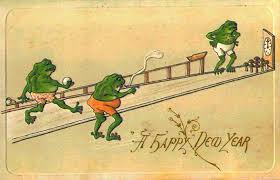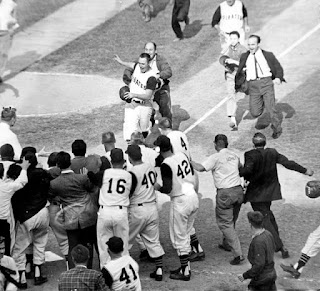". . .in those years around the sea-town corner now, out of all sound except the distant speaking of the voices I sometimes hear a moment before sleep, that I can never remember whether it snowed for six days and six nights when I was twelve, or whether it snowed for twelve days and twelve nights when I was six."
--from A Child's Christmas in Wales by Dylan Thomas
Pulling cousins Larry and Jean around on a sled, 1948.
Wherever you live, there's probably a weather event that stands out in your memory: a hailstorm, a tropical storm, a flash flood. For many who live in the northern states, it's a snowstorm that people remember. My family remembers the Halloween blizzard of 1991 in Minnesota. Three feet of snow fell overnight, clogging up the roads, trapping people in their homes. I remember slogging three blocks to the local grocery store on snowshoes. It took many days to clear the streets and alleys of Minneapolis of snow, and what was on the ground stayed until March.
Downtown Minneapolis during the blizzard--Photo by NWS
The other snowstorm that is etched in my memory--but one that is a childhood memory--is the Thanksgiving weekend snowstorm of 1950, dubbed "The Great Appalachian Storm" by the National Weather Service:
"One of the most damaging and meteorologically unique winter storms to strike the eastern United States occurred on Thanksgiving weekend 1950. After it was over, as much as 57 inches of snow blanketed the central Appalachians (with locally up to 62 inches at Coburn Creek, WV) and one of the most widespread and damaging wind events ever recorded over the Northeastern U.S. made the Great Appalachian Storm of 1950 the costliest storm on record up until that time. . . .A unique feature with this storm was the wild temperature gradient produced as the arctic airmass wrapped southeastward around the low, while warm air from the Atlantic was pulled northwestward. Case in point, Pittsburgh, PA received 30.5” of snow and recorded temperatures in the single digits while only 200 miles to the north, Buffalo, NY enjoyed temps in the 40s and recorded no snow at all."
Map of snowfall totals for the November 22-28, 1950 storm. Colored shading represents 10-inch increments. Image credit: From Northeast Snowstorms Vol. 2 , Paul Kocin and Louis Uccellini.
Streetcar stuck in snow, Pittsburgh, 1950. Photo by Walter Stein.
The storm began in the Carolinas and tracked northwesterly into the Ohio Valley, reaching Pittsburgh on the day after Thanksgiving. People knew it was a bad storm from news report from West Virginia and Kentucky. But we really had no idea how bad it was until it hit.
On Thanksgiving my parents and I walked the two blocks to my Aunt Estella's house for dinner. My cousin Grace, Estella's daughter, who was an adult at the time, remembers it as being a big feast, with an extra table set up to accommodate the guests. What I remember is what followed the next day.
On Friday evening the snow began to fall. The wind howled all night long as the snow fell. The next day we woke up to an astounding sight: everything covered with a thick blanket of snow. We had snowstorms, when, for a day or so, we kids could sled down the James Street hill. Then the trucks would come and spread cinders and ashes, and that was the end of that. Usually, the snow would be melted in a few days.
But this storm was different. I recall looking out the front door--which was blocked with deep snow--and seeing white everywhere. As my dad began shoveling from the front door to the sidewalk, other neighbors emerged. People were in shock, wondering how they were going to get out of the neighborhood. The snow was way too deep to sled. The official Pittsburgh snowfall total was 30.5", still the record.
People digging out cars on our block of James Street.
Pittsburgh and the river towns around it didn't have a lot of snow removal equipment. No snowblowers, no winter tires. If you had to get around when the roads were snow-covered, you put chains on the tires. I recall only two times that Dad had to do this. After this snowfall, however, no one was going anywhere. Stores were closed. The streetcars weren't running. The main arteries were clogged with snow. People couldn't get to work, or in some cases, get home from work. Estella's husband David couldn't get to his shift at the Homestead Works, only a mile down the hill from their home.
As neighbors on E. James Street were digging out Saturday afternoon, Dad got out his camera.
Our house is the one just over my left shoulder
It would take days of shoveling and plowing for residents to be able to move around the city. Much to the delight of many children, schools were closed all the next week. We never got "snow days" in Munhall, so this was quite extraordinary. We lived only a block away from Woodlawn School, where my dad taught. He could get to school, but few other teachers could.
As in Dylan Thomas's A Child's Christmas in Wales, some Munhallers who were students at the time have vivid recollections of this storm, but it's in vignettes:
--Nancy: I was three and I remember the snow was taller than I was. Maybe I remember that because I’ve been told so, but I honestly feel like I remember looking up at the snow from the shoveled pathway.
--Joe: We had about three feet of snow at our home. A few days later, we heard that a store was opened on Whitaker Way. My father and I made the trek with me on a sled for a few essentials.
--Richard: Lived on 14th at that time. No cars or trucks coming up the hills. My dad loaded me and my sister on a sled. We then went down to 8th Avenue as there were delivery trucks traveling there. We got the bread butter milk and eggs . Me and my sister held on to bags as my dad toted us back up the hill.
Barbara: I was living in Whitaker, and Dutch Ackerman, our mayor provided families with milk and water. And we were sledding down Spur Road!
Wayne: As I recall the street cars even stopped running. My cousin Donna and I were sled riding on West Street near 16th avenue!
Nadine:























































